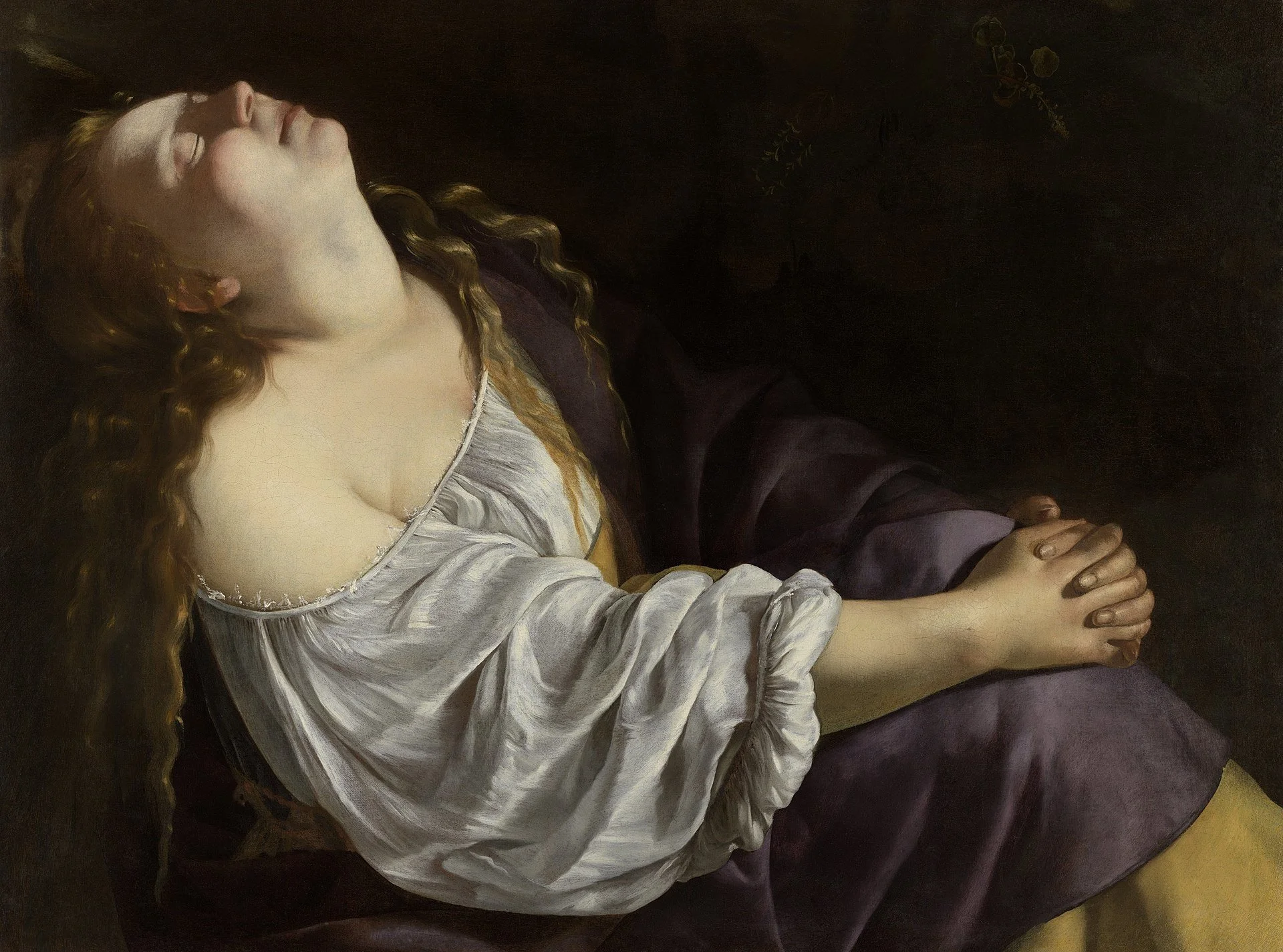La bella peccatrice: 17th Century Cantatas on Mary Magdalene
St. Mary Magdalene
Mary Magdalene, portrayed with stunning detail and emotion in Titian's 16th century masterpiece.
Throughout the Baroque period, many composers were drawn to the figure of Mary Magdalene, making of her a muse for their musical compositions. Her duality as both a repentant sinner and devoted follower of Christ made her a rich subject for exploration in both sacred and secular music. From oratorios to solo cantatas and monodies, composers captured her emotional depth, often focusing on themes such as her sorrow at the foot of the Cross or her transformation through faith. In my work as an editor, I have revisited several pieces dedicated to Mary Magdalene, each offering nuanced ways in which 17th century composers portrayed her multifaceted nature.
Luigi Rossi composed no less than three cantatas centered on the figure of Mary Magdalene: ⏵︎ Pender non prima vide, O grotta, o speco, o sasso, and ⏵︎ Un allato messaggier.
Pender non prima vide follows a structure commonly found in secular lamenti, beginning with a narrator who sets the stage for Mary's emotional monologue. In O grotta, o speco, o sasso, Rossi evokes the cave of Sainte Baume in Provence, where tradition holds that Mary Magdalene spent her years in penance. This piece highlights her search for redemption, with its opening marked by an ascending melodic line that carries a sense of solemn invocation, depicting the depth of her spiritual longing.
Mary Magdalene in a Landscape by Annibale Carracci (1560-1609), on display at the Fitzwilliam Museum.
⏵︎ Un allato messaggier is an anonymous contrafactum of Rossi's famous lamento ⏵︎ Un ferito cavaliero. The original cantata is a lament of the Queen of Sweden upon her husband Gustav's death, and the contrafactum replaces the queen's sorrow with Mary Magdalene's affliction for the death of Jesus. The composition begins with a winged messenger paying obeisance to the “divine woman” and disclosing the tidings of the Lord's death, before focusing entirely on Mary Magdalene's tearful sorrow expressed in the first person.
Mary Magdalene in Ecstasy: A captivating portrayal by Artemisia Gentileschi, 17th century Italian Baroque painter.
Girolamo Frescobaldi's ⏵︎ A piè della gran Croce (Maddalena alla Croce) from his Primo libro d'Arie Musicali (1630) evokes a deeply emotional atmosphere as it depicts Mary Magdalene. It is a monody in stile recitativo. This sonetto spirituale conveys Mary Magdalene’s profound grief as she stands at the foot of the Cross, witnessing Christ's death. The text vividly captures her lament, with imagery of her disheveled hair and flowing tears, reflecting more the sorrow of a lover mourning her beloved than a conventional profession of faith. The emotional weight of the piece is heightened by Magdalene's plea, questioning how she can live without Christ and expressing a desire to share both life and death with Him. Frescobaldi’s musical setting intensifies this intimate sorrow, emphasizing the personal, almost sensual, bond between Mary and Jesus' suffering.
In Domenico Mazzocchi's ⏵︎ Lagrime amare (La Maddalena ricorre alle lagrime), Mary Magdalene is portrayed in her most iconic and intimate role—overcome with tears. Unlike other depictions that place her at the foot of the cross or in a cave, this piece focuses solely on the act of weeping, a central symbol of her repentance and sorrow. The poetic text emphasizes the redemptive power of her tears, likening them to a healing force that cleanses the soul from the pain inflicted by the "cruel serpent of Hell."
Musically, Lagrime amare alternates between expressive arioso and recitativo sections, mirroring the emotional ebb and flow of the text. Mazzocchi employs madrigalisms, chromaticism, and coloratura to enhance the emotional intensity, allowing the music to reflect the depth of Magdalene's sorrow and the spiritual weight of her tears.
The contrafacta of Monteverdi's ⏵︎ Lamento d’Arianna include the well-known spiritual adaptation titled ⏵︎ Pianto della Madonna (Iam moriar mi fili) from Selva morale et spirituale, Venice,1640, which was approved by Monteverdi himself. But another interesting and lesser known contrafactum is the ⏵︎ Lamento della Maddalena, which centers around Mary Magdalene and seems to have been created after the composer’s death, is preserved in Museo internazionale e biblioteca della musica di Bologna (MS Q.43, ff. 90v-95r). This lament serves as a parody of Monteverdi's highly popular Lamento d’Arianna and exemplifies the practice of contrafactum, where the original vocal music retains its melody while the text is replaced with a new one, thus creating a different thematic focus without substantial alterations to the music itself.
If you're interested in delving into the musical works inspired by Mary Magdalene during the 17th century, I invite you to check out my thoughtfully curated playlist on this fascinating topic: 17th century ⏵︎ Cantatas on Mary Magdalene. Within this collection, you'll discover a selection of beautiful and haunting pieces, including the cantatas by Luigi Rossi that I discussed in this post.
For those who wish to delve even deeper, I have transcribed these cantatas and made them available for purchase at my virtual store. I hope you enjoy this journey through the musical expressions of devotion and reflection inspired by this intriguing biblical figure. I also highly recommend María Cristina Kiehr's beautiful anthology album Canta la Maddalena with Concerto Soave (Harmonia Mundi, 2000) and Teresa Gialdroni's insightful article. Both works inspired me to edit these pieces about Mary Magdalene, the beautiful sinner.
Reference:
Gialdroni Teresa, M. (2018). Cantatas on Mary Magdalene, a sinner and holy woman. In E.B. Michael Pauser (a cura di), Denn Musik ist der größte Segen...Festschrift Helen Geyer zum 65. Geburtstag (pp. 61-76). Sinzig : Studio Verlag.


